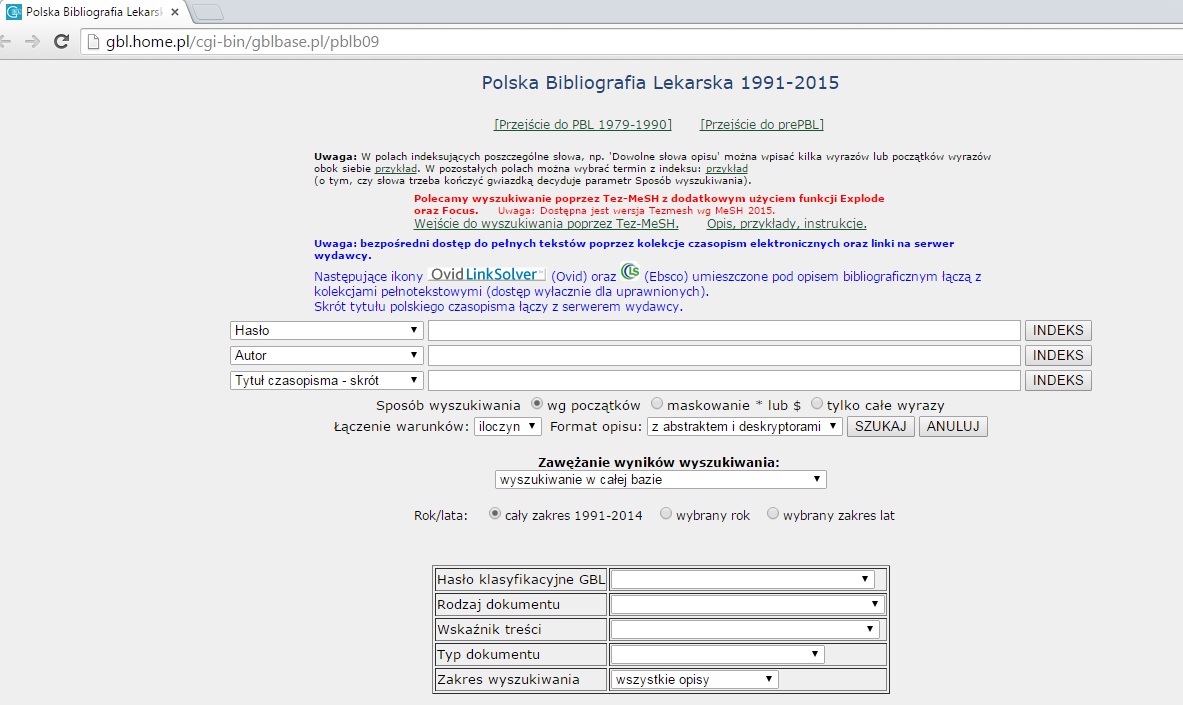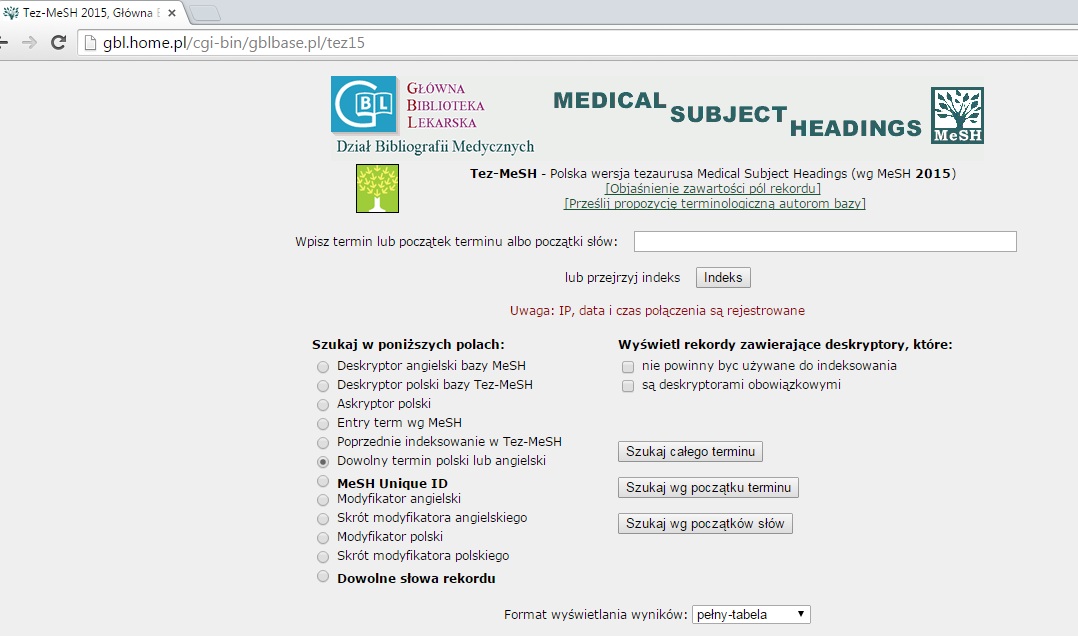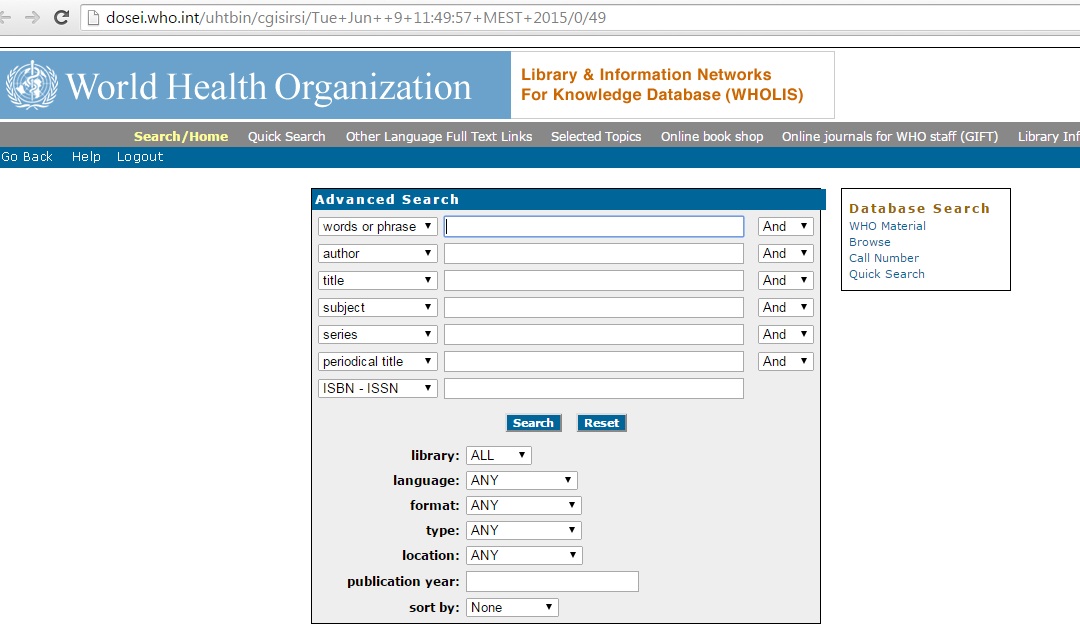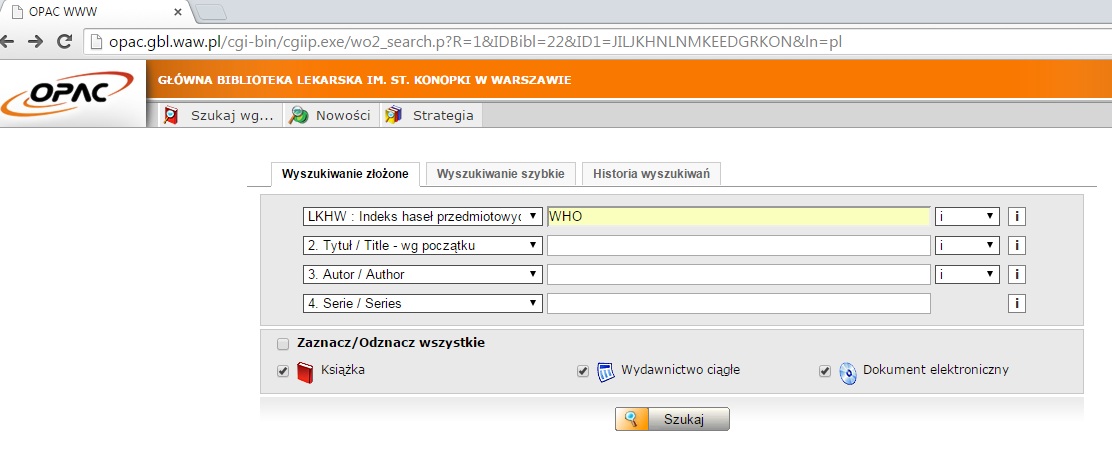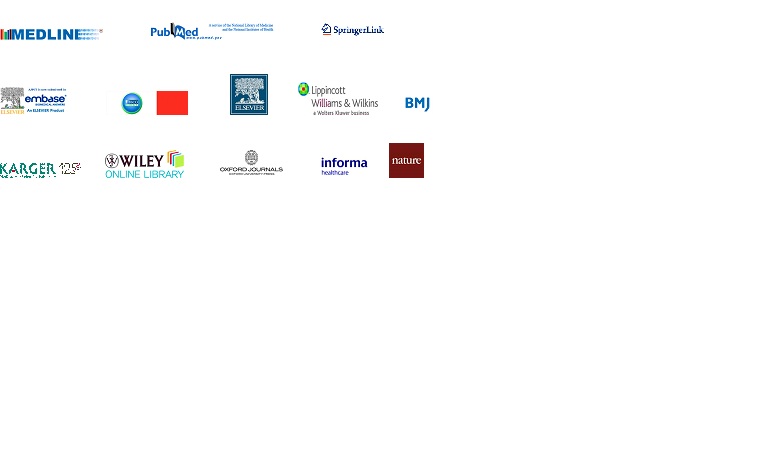Main Medical Library Databases
-
Copyright
© 2015 PRO MEDICINA Foundation, Published by PRO MEDICINA Foundation
User License
The journal provides published content under the terms of the Creative Commons 4.0 Attribution-International Non-Commercial Use (CC BY-NC 4.0) license.
Authors
| Name | Affiliation | |
|---|---|---|
Wojciech Giermaziak |
Main Medical Library |
Creation of Medical Information Center (CIM) in the Main Medical Library enabled continuation and updating highly specialized information databases, which allows CIM to qualify as an opinion-forming instrument tool in the government activities.
The Main Medical Library since 2002 functioning also as the World Health Organization (WHO) Documentation Center. WHO’s publications in field of medicine and related sciences are collected, compiled and made available in the premises of the library. The Main Medical Library also allows the use of electronic databases of the fulltext journals.
Introduction
Terminology about register in the health care system should not be limited only for the medical records systems of healthcare facilities, managed both electronically (computerized) and on paper. Databases collecting information in the field of medicine, related sciences and public health may also be regarded as a specific type of registry.
Polish Medical Bibliography
A well-known and highly respected example of this type of database is "Polish Medical Bibliography" (PBL), created in the Medical Information Center in Main Medical Library in Poland. Polish Medical Bibliography is the oldest and most comprehensive abstracts medical database. Medical Information Center continues process of PBL creating, which was started originate by its founder Stanisław Konopka and automated in the seventies of the 20th century by Scientific Medical Information Department set up for this purpose.
The system records polish scientific and clinical literature, professional in the field of medicine and related sciences, health care management, as well as popular literature in the field of health education. The database also contains monographs and unpublished doctorates and habilitations belonging to the collections of the Main Medical Library.
PBL database is not only a register of medical casuistry (described case studies), but also through a significant number of original published articles, shows, among other, the epidemiological picture of the Polish population and other countries, as well as describes the results of the effectiveness of various forms of prevention and treatment of diseases. Polish Medical Bibliography is appreciated worldwide bibliographic-abstracts database.
Experts from an international non-profit organization "the Cochrane Collaboration" which analyzed PBL database have found that close to 40 percent of randomized controlled trials records found in the database is not registered neither in Medline, neither in Embase, which testifies that system has got rich and valuable information resources. PBL is a valuable source of information for both health care system users, as well as public health researchers. It provides significant support for health care personnel in the process of diagnosis, treatment, analysis of the results of the practice guideline. It is also used as a very useful source of data for epidemiological and pharmacoepidemiological studies, in health care economics researches, with regard to a whole range of diseases.
The database includes over 400 000 records, making it one of the largest specific bibliography in Poland. The recorded data come from more than 250 Polish periodicals and about 200 foreign magazines. It is carried out in an automatic way since 1979, on a regular basis and updated every 3 months. Since 1991, Polish and English summaries of articles are entered into the database. The data included in the database are properly classified in order to optimize readability of database records, facilitate access to information and reduce the time of target information searching. PBL is available for users for self-searching and also there is a possibility to prepare thematic summaries of literature on individual orders by GBL employees [1]. Searching may be carried out according to each significant element of the bibliographic and description of the content, for example: by the words of the title and abstract, descriptor, title, journal, year of issue, etc. (Fig.1).
Source:http://gbl.home.pl/cgi-bin/gblbase.pl/pblb09
Tez-MeSH Database
Another data system functioning in the Main Medical Library is Thesaurus-MeSH (Tez-MeSH), which is the Polish version of the American Thesaurus, Medical Subject Headings (MeSH), carried out as a part of the Unified Medical Language System by the National Library of Medicine of the United States (National Library of Medicine-NLM). Mesh is functioning as an information-searching language of one of the most famous and recognized by the world medical system - Medlarse /Medline. The database contains English and Polish nomenclature in the field of medicine, related sciences and health care system organization. Terminology included in the database along with indexing rules adopted from NLM, applies to prepare special documents – characteristics, which were introduced since 1979 to the PBL database and library catalogues. The implementation of Tez-MeSH Database to Polish Medical Bibliography (in 2007), greatly facilitated the process of searching in bibliographic database with the ability to use a descriptor tree [2].
Tez-MeSH system is available for free in the on-line version for medical schools libraries, other schools and medical institutions, academies of physical education and scientific research institutes of the Ministry of Health. Permanently it is used by more than 30 scientific and educational institutions. Figure 2 (Fig.2) presents methods of searching in the database.
.
Source: http://gbl.home.pl/cgi-bin/gblbase.pl/tez15
World Health Organization Database
The Main Medical Library since 2002 functioning as World Health Organization (WHO) Documentation Center. WHO’s publications in field of medicine and related sciences are collected, compiled and made available in the premises of the library. WHO Regional Office for Europe based in Copenhagen send systematically directly to the GBL or through the WHO Office in Poland, the latest publications from the World Health Organization institutions and development by experts from various fields carried out on behalf of the WHO organization. The Center currently offers more than 4000 publications and studies on various medical issues, statistics about health status and incidence of various types of diseases, a global health reports published annually by WHO and other development studies. Methods of searching in the database are presented below (Fig.3., Fig.4.).
Source: http://dosei.who.int/uhtbin/cgisirsi/Fri+Jun+19+04:00:43+MEST+2015/0/49
Source:
http://opac.gbl.waw.pl/cgi-bin/cgiip.exe/wo2_search.p?R=1&IDBibl=22&ID1=JILJKHNLNMKEEDGRKON&ln=pl
Foreign bibliographic databases – e-magazines
The Main Medical Library also allows the use of electronic databases of the fulltext journals; they are available at the premises of the library as well as in the GBL’s branches. One of the most famous and appreciated database is the Medline Database, created by the National Center for Biotechnology Information at the National Library of Medicine in the USA. It is an electronic version of the Index Medicus, which began publication in 1966. Currently it registers more than 12 million articles from 4,600 journals from 70 countries. Its chronological range covers the period from 1966 to the present day. Since 2002 it is updated daily. About 2000 records are added per day. Approximately 52% of the records represent article published in the USA, 86% of articles are in English language. Medline is an essential component of PubMed Database. In addition to Medline it is also available: Oldmedline - containing 1.5 million descriptions of articles from the years 1953-1965; Pubmed In Process - which includes articles prepared for inclusion in Medline and Pubmed As Supplied By Publisher - presents data on articles submitted by publishers. Pubmed contains 89% of records in English. It indexes magazines in 29 languages in addition to English magazines.
Another database is Embase, published by Elsevier. It is divided into: Embase Classic - Archival records of Excerpta Medica Abstract Journals (1947-1973) and Excerpta Medica - since 1974 to the present day.
It provides access to bibliographic records of articles from 7,000 journals, of which 1,800 biomedical journals is not indexed by Medline. Profile of indexed journal is more international than Medline, since 1989, with a particular focus on European literature [3,4].
The next system is an Elsevier Database, which presents electronic versions of Elsevier scientific journals published since 1995, including tables of contents, bibliographic data, abstracts and full text articles along with graphics. It contains 1,901 titles of magazines, including 1480 updated on a regular basis every week and 421, which are no longer updated. Another shared thematic platform is created by Wiley Online Library, since 2010. It includes electronic publications from a combination of earlier operating databases Blackwell Synergy and Wiley Interscience. It contains resources of publishes such as John Wiley & Sons, Wiley-Blackwell, Wiley-VCH, Jossey-Bass. On the platform there are more than 4 million articles from 1500 scientific journals. The database increases by almost 200 new records each month [5]. The Springer Database, in turn, every day updates 419 journals publishing by Springer Verlag. Next database, EBSCO is existing since 1994. It is a company's platform of scientific journals published by EBSCO. It includes, among others, databases such as: Medline Complete - the world's most comprehensive source of full text medical journals, contains articles from over 1,800 journals indexed in Medline. The full text articles date back to 1857.
The other available databases also should be mentioned, such as (Fig.5.):
- Academic Search complete – database of 8500 full text journals, indexes and abstracts of 12500journals chronological range from 1887;
- Health Source - contains 550 full text scientific journals;
- Oxford Journals - electronic versions of 95 medical journals published by Oxford University Press (base archives date back to 1996);
- Lippincott, Williams & Wilkins - electronic versions of 104 medical journals;
- BMJ - 28 medical titles of full text journals published by BMJ Publishing Group. Since 1998, it was the electronic version of the printed journal British Medical Journal, published since 1840. In 1999, BMJ Publishing Group as the first magazine greatly extended versions of selected articles published in the Internet [6];
- Karger - a collection of 76 biomedical Karger full text journals; offering access to current numbers immediately, before publishing on paper;
- Informa Healthcare - 160 periodicals published by Informa Healthcare with a chronological range from 1997 to the current issue;
- Nature - allows access to the electronic version of the prestigious, existing since 1869 the British scientific journal Nature; Base chronological range extends from 1997 to the current issue.
Medical Information Center
The current health policy is focused on use of various type of health data systems created for research, clinical trials and studies evaluate health care system. Many institutions change profile activity, concentrating on collecting, processing and purposeful use of available scientific information, which allows using them as a tool in the government activities. The care about the reliability of sources of information and the quality of such data seems to be significant.
Creation of Medical Information Center (CIM) in the Main Medical Library enabled continuation and updating highly specialized information databases, which allows CIM to qualify as an opinion-forming unit (independent of lobbying influence), auxiliary tool in making decisions process about changes and procedures in the Polish health care system. The functioning of the CIM assume using the potential of individuals, such as GBL, AOTM, HTA and Medical Audit Agency. The Medical Information Center turns out to be an innovative instrument in shaping the administrative decisions concerning for example medicinal products market. PBL Database is a reliable source of current information concern all aspects of the Polish pharmaceutical market. The Main Medical Library is also the general distributor of World Health Organization’s scientific information. The data system allows access to the Polish and global scientific achievements. Information obtained through the database is used in CIM for: professional preparation the most optimal system solutions in health care; creation of tips which could improve registration and authorization of food supplements and medical devices on the Polish drug market system; as well as substantive justification for the change or creation a new medical law by identifying the most secure solutions in the assessment of international research that should be implemented into national law. The aim of CIM is also cooperation with European Union members and global range, to optimize solutions in the Polish health care system as part of integrated systems in Europe, including variety aspects; for example immunization by vaccination.
The proper functioning of health records systems require their constant evolution, depending on the changing needs and expectations of users. Continuous improvement of systems is a necessity, especially if we take into account the promotion of international studies comparing the quality of care and efficiency of health care systems. All these activities should serve a common purpose health policy - strengthening the information infrastructure.
References:
- Włostowska Ewa, Głębocki Jacek, Polska Bibliografia Lekarska Głównej Biblioteki Lekarskiej w roku swojego trzydziestolecia, (w) Bibliograficzne bazy danych, kierunki rozwoju i możliwości współpracy, Bydgoszcz 2009 (dokument elektroniczny).(online)(dostęp 2015-30-10).Dostępny w World Wide Web:http://www.ebib.info/publikacje/matkonf//mat19/wlostowska_glembocki
- Włostowska Ewa, Głębocki Jacek, Chrobak Ewa, Nowoczesne metody samodzielnego przeszukiwania bazy danych Polska Bibliografia Lekarska, Forum Bibliotek Medycznych 2009, r.2, nr 1(3), s.283-291
- Budek Dagmara, Rogowska Edyta, Bazy danych w bibliotekach medycznych w Polsce, Forum BibliotekMedycznych 2008, r.1, nr 1, s.374-379
- Przyłuska Jolanta, Wykorzystanie bazy Medline do analizy polskiego piśmiennictwa z medycyny pracy, Forum Bibliotek Medycznych 2008, r.1, nr 1, s.379-388
- Przydańska Alina, Lewinson Jacek, Nowa platforma wydawnictwa Wiley and Sons, Forum BibliotekMedycznych 2010, r.3, nr 2(6), s.117-132
- BMJ(dokument elektroniczny).(online) (dostęp 2015-03-15).Dostępny w World Wide Web: http://www.bmj.com/company/who-we-are/bmj-timeline/






